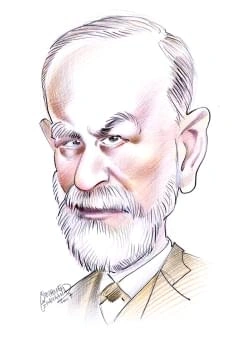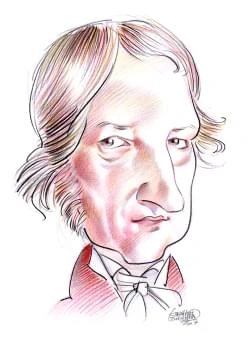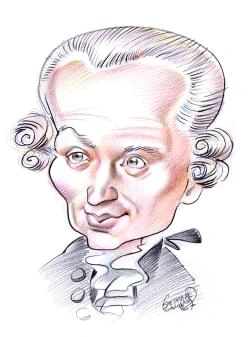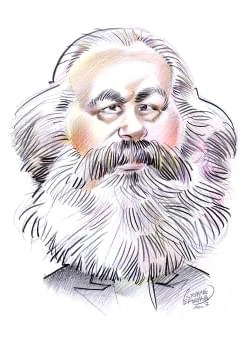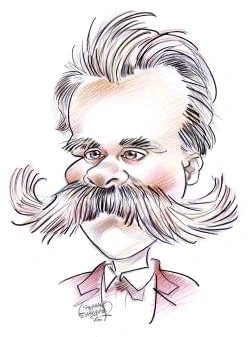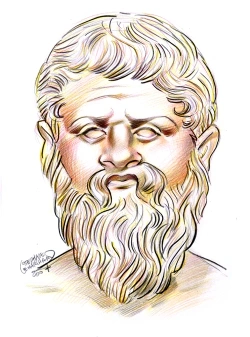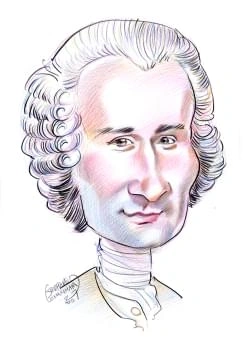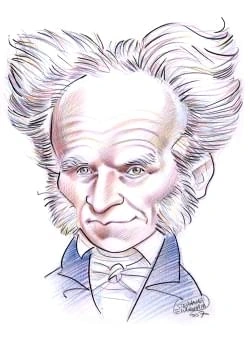80 résultats pour "surroundings"
- Mephitis (Mefitis) Roman A goddess who protected the people of Rome and surrounding cities in Italy from the dangerous fumes of sulphur that spewed from the many volcanoes and the gaseous vents surrounding them.
-
Molecule - chemistry.
attracted to the negatively charged electrons between them. The electrons belong to the molecule as a whole. However, each hydrogen atom now has a complete outershell of two electrons. The formula H 2 describes a hydrogen molecule, a discrete unit. When a molecule contains just two atoms, such as the hydrogen molecule does, it is called a diatomic molecule. Some atoms can form covalent bonds with more than one other atom and thus create a larger molecule. Atoms form molecules with covalent bo...
-
Animal - biology.
Vertebrates are customarily divided into cold-blooded and warm-blooded animals, but these labels are not very precise. Biologists normally use the terms ectoderm and endoderm to describe temperature regulation more accurately. An ectoderm is an animal whose temperature is dictated by its surroundings, while an endoderm is one that keeps its body at a constant warm temperature by generating internal heat. Reptiles, amphibians, and fish are ectoderms. Although they do not maintain a constant wa...
-
Weather.
hours, and the snow can be much deeper in places where the wind piles it up in drifts. Extraordinarily deep snows sometimes accumulate on the upwind side ofmountain slopes during severe winter storms or on the downwind shores of large lakes during outbreaks of polar air. VI WIND Wind is the horizontal movement of air. It is named for the direction from which it comes—for example, a north wind comes from the north. In most places near theground, the wind speed averages from 8 to 24 km/h (from 5...
- Rutuli (Rutulians) A people of ancient Italy inhabiting Ardea and the land surrounding Latium.
-
Los Angeles - geography.
size and population) among all the cities in Los Angeles County. It is irregular in shape because it has grown over the years through the annexation of surrounding territoryand cities. The city proper is shaped like a lighted torch, its narrow handle extending north from the Port of Los Angeles to downtown Los Angeles, and its flames flickeringirregularly to the north, west, and northwest. Several separate cities—such as Beverly Hills, Santa Monica, and Culver City—are partly or completely surro...
-
Boston - geography.
The neighborhoods of Allston and Brighton occupy the northwest corner of the city to the west of Fenway. The Allston-Brighton area is bordered to the east, north, andwest by the Charles River and to the south by the Massachusetts Turnpike and the town of Brookline. It is an industrial and residential neighborhood that is also thelocation of Boston College and Harvard University Business School. Boston has been unsuccessful in annexing Brookline, the birthplace of U.S. president John F.Kennedy an...
-
Space Exploration - astronomy.
to produce 250,000 newtons (56,000 lb) of thrust. The Germans launched thousands of V-2s carrying explosives against targets in Britain and The Netherlands. Whilethey did not prove to be an effective weapon, V-2s did become the first human-made objects to reach altitudes above 80 km (50 mi)—the height at which outer spaceis considered to begin—before falling back to Earth. The V-2 inaugurated the era of modern rocketry. A2 Early Artificial Satellites During the years following World War II, the...
-
- Berlin Wall Berlin Wall, fortified wall surrounding West Berlin, built in 1961 and maintained by the former German Democratic Republic (GDR), commonly known as East Germany, until 1989.
- A1 A N D I N G S P E A K I N G W R I T I N G B1 B2 C1 C2 Listening I can recognise familiar words and very basic phrases concerning myself, my family and immediate concrete surroundings when people speak slowly and clearly.
-
Colorado (river, North America) - Geography.
sometime between AD 1300 and 1400, but their descendants, the Hopi and Pueblo people, continue to farm and irrigate using the river's waters. The first European to visit the river was probably Spanish soldier and explorer Francisco de Ulloa, who explored the mouth of the Colorado in 1539. In 1540 and 1541another Spaniard, Francisco Vásquez de Coronado, traveled through much of the region around the Colorado River. An exploring party from the Coronado expedition,led by Garcia López de Cárdenas,...
-
Temple (building)
I
INTRODUCTION
Wat Phra Kaeo
Thailand has nearly 18,000 Buddhist temples, called wats, throughout the country.
colonnaded terraces connected by ramps. The surrounding area was planted with trees and flowers during Hatshepsut’sreign and for many years after.Gian Berto Vanni/Art Resource, NY In ancient Egypt, temples were grandiose, built of huge blocks and columns of stone. Often they were enlarged by successive rulers to form strung-out series of templeparts, as in the gigantic Temple of Amon (circa 1550-1070 BC) at Al Karnak. The Nile cliffs were used as settings for temples, such as the massive mortuar...
-
Bat - biology.
tomb bat has rather small ears. The shapes of bat ears are extremely varied. The wide ears of the Australian false vampire bat meet above the head and are fused.Many bats are able to turn their ears in the direction of faint noises. Bat hearing and its use in echolocation are highly developed. Some bats have large, conspicuous eyes, while others may have small beady eyes. This variation suggests that vision plays different roles in the lives of various species.Despite the familiar expression, 'b...
-
Fish - biology.
pectoral fins provide fine movements, add forward thrust, or, together with the pelvic fins, serve as brakes. Typically, fins consist of a thin membrane stretched over afanlike series of thin rods called spines or rays. Most fish breathe underwater with the help of special respiratory organs called gills. Gills are made of a series of thin sheets or filaments through which blood circulates.As water moves into a fish’s mouth and passes over the gills, dissolved oxygen passes across the thin gill...
-
Fire - chemistry.
were usually natural caves. Eventually people learned to dip branches in pitch to form torches. They created crude lamps by filling a hollowed out piece of stone withmoss soaked in oil or tallow (a substance derived from animal fat). By cooking with fire, prehistoric people made the meat of the animals they killed more palatable and digestible. They learned to preserve meat by smoking it over a fire,vastly decreasing the danger of periodic starvation. Cooking also enabled them to add some for...
-
Archaeology.
Prehistoric archaeology is practiced by archaeologists known as prehistorians and deals with ancient cultures that did not have writing of any kind. Prehistory, a term coined by 19th-century French scholars, covers past human life from its origins up to the advent of written records. History—that is, the human past documented insome form of writing—began 5000 years ago in parts of southwestern Asia and as recently as the late 19th century AD in central Africa and parts of the Americas. Becaus...
-
-
Cancer (medicine).
unable to repair the DNA damage, p53 instructs the cell to undergo programmed cell death, or apoptosis , putting a stop to runaway cell division before it starts. Programmed cell death is a normal part of cell life and is tightly controlled by many genes, primarily p53. In a cancerous cell, one or more mutations prevent these genes from doing their jobs. When mutated, p53 allows a cell to continue to divide, even with damaged DNA.This can lead to additional mutations in proto-oncogenes or tumor...
-
Comparative Anatomy.
In comparing two species, anatomists have to be careful to differentiate between homologous structures, which are ones that have evolved from a shared ancestor, andanalogous structures, which have developed from different origins. Homologous structures are built on the same underlying plan. A human arm, a bat’s wing, and awhale’s flipper look quite different from the outside, but the bones inside reveal that these limbs all have the same basic structure. Analogous structures, by contrast,often l...
-
Frank Lloyd Wright
I
INTRODUCTION
Robie House
The Frederick C.
Hills/DeCaro HouseAmerican architect Frank Lloyd Wright, a pioneer of modern architecture, lived and worked in the Chicago area during thelate 19th and early 20th centuries. He designed many single-family houses, known as prairie houses. The Hills/DeCarohouse in Oak Park, west of Chicago, is one of more than 20 houses Wright designed while living in the town between 1890and 1910.© 2007 Frank Lloyd Wright Foundation / Artists Rights Society (ARS), New York / Photo: Mary Ann Hemphill/Photo Researc...
-
Perception (psychology).
A4 Closure According to the law of closure, we prefer complete forms to incomplete forms. Thus, in the drawing below, we mentally close the gaps and perceive a picture of a duck. This tendency allows us to perceive whole objects from incomplete and imperfect forms. A5 Common Fate The law of common fate leads us to group together objects that move in the same direction. In the following illustration, imagine that three of the balls are moving in one direction, and two of the balls are mo...
-
Whale - biology.
III BEHAVIOR OF WHALES Studies of whales in captivity have taught scientists much about the complex social behavior of whales. Since the late 1980s, advances in the use of satellite trackingsystems have also broadened opportunities for scientists to observe how whales behave in the wild. A Swimming and Diving Whales swim by making powerful up-and-down movements of the tail flukes, which provide thrust. The power comes from body muscles that flex the lower spine upand down in a wavelike motion...
-
Australia - country.
itself forms most of the border between New South Wales and Victoria. Considerable lengths of the Murray, Darling, and Murrumbidgee rivers are navigable during thewet seasons. The central plains region, also known as the Channel Country, is interlaced by a network of rivers. During the rainy season these rivers flood the low-lying countryside,but in dry months they become merely a series of water holes. The Victoria, Daly, and Roper rivers drain a section of the Northern Territory. In Queensland...
-
Australia - Geography.
itself forms most of the border between New South Wales and Victoria. Considerable lengths of the Murray, Darling, and Murrumbidgee rivers are navigable during thewet seasons. The central plains region, also known as the Channel Country, is interlaced by a network of rivers. During the rainy season these rivers flood the low-lying countryside,but in dry months they become merely a series of water holes. The Victoria, Daly, and Roper rivers drain a section of the Northern Territory. In Queensland...
-
Japan - country.
island’s fertile soils support agriculture and provide the vast majority of Japan’s pasturelands. In addition, Hokkaidō contains coal deposits, and the cold currents off itsshores supply cold-water fish. Winters are long and harsh, so most of Hokkaid ō is lightly settled, housing about 5 percent of Japan’s population on approximately 20 percent of its land area. However,its snowy winters and unspoiled natural beauty attract many skiers and tourists. Hokkaid ō is thought of as Japan’s northern fr...
-
-
Frank Lloyd Wright.
C Usonian Houses Wright achieved his goal of low-cost, democratic American architecture with his Usonian houses of the 1930s. Usonia was Wright’s term for the United States of North America, with an i added for a pleasing sound. The Usonian house had a simple design, usually with an L-shaped floor plan. This plan separated the noisier living space on one leg of the L from the quieter bedroom space on the other leg. The floor was made of concrete slabs, typically in a square grid of 4 by 4...
-
Antarctica - geography.
The geographic South Pole lies near the center of the continent in East Antarctica. This point is where all map lines of longitude converge at the southern end ofEarth’s axis of rotation. Distinct from the geographic south pole is the south magnetic pole, where the lines of force of Earth’s magnetic field emerge vertically,arching upward over the planet to enter Earth again at the north magnetic pole. The south-seeking end of a compass needle points to the south magnetic pole. Thesouth magnetic...
-
Dallas (Texas) - geography.
VI RECREATION Dallas contains more than 400 parks that cover a total of about 20,000 hectares (about 50,000 acres). Notable parks include Marsalis Park, which contains the DallasZoo, and the parks surrounding White Rock Lake, Bachman Lake, and Lake Cliff. City-owned greenbelts parallel White Rock Creek, Turtle Creek, and the Trinity River.Fair Park contains a number of museums, the city aquarium, and the Cotton Bowl stadium (the site of the annual Cotton Bowl college football game), as well as...
-
Kiribati - country.
mainly from Japan, the European Union (EU), and Australia. Kiribati’s only major exports are copra (dried coconut meat), cultivated seaweed, and fish. The United States, Australia, and New Zealand are the leading purchasers ofthe country’s exports. Despite the cultivation of crops for local consumption, Kiribati is heavily dependent upon imported foods. Other imports include machinery andequipment, manufactured goods, and imported fossil fuels, which supply most of the country’s energy. Australi...
-
Rio de Janeiro (city) - geography.
were coronated; and Our Lady of Candelária Church, thought by some to be the city’s most beautiful church. Another building of interest is the Imperial Palace, located several blocks west of Santos Dumont Airport. Originally constructed as Brazil’s colonial governor’s capitol in1743, it was converted to the royal palace during the city’s period as an imperial capital. It has recently been restored and now houses a cultural center. Otherimpressive 19th-century palaces include Itamaraty and Catete...
-
Earthquake.
III CAUSES Most earthquakes are caused by the sudden slip along geologic faults. The faults slip because of movement of the Earth’s tectonic plates. This concept is called theelastic rebound theory. The rocky tectonic plates move very slowly, floating on top of a weaker rocky layer. As the plates collide with each other or slide past eachother, pressure builds up within the rocky crust. Earthquakes occur when pressure within the crust increases slowly over hundreds of years and finally exceeds...
-
Puerto Rico - geography.
the length of the day remains fairly constant throughout the year. San Juan has a mean July temperature of 28°C (83°F) and a mean January temperature of 25°C (77°F). The average temperature of the seawater surrounding theisland is 27°C (81°F), with little variation during the course of the year. The entire island is cooled by the trade winds from the northeast. This air also contains much water vapor. As the air is forced to rise over the mountains, it becomescooler and the water vapor condenses...
-
Cell (biology) - biology.
proteins, or other proteins required by the cell. While relatively simple in construction, prokaryotic cells display extremely complex activity. They have a greater range of biochemical reactions than those found in theirlarger relatives, the eukaryotic cells. The extraordinary biochemical diversity of prokaryotic cells is manifested in the wide-ranging lifestyles of the archaebacteria andthe bacteria, whose habitats include polar ice, deserts, and hydrothermal vents—deep regions of the ocean un...
-
-
Mexico City - geography.
The park houses some of Mexico's most important public buildings, including Chapultepec Castle. Construction of the castle began in 1783. Positioned on the park’shighest elevation, the castle functioned as a fortress during colonial times. It once served as the presidential residence and now houses the National Museum of History,which includes murals by 20th-century Mexican painter Juan O'Gorman. Los Pinos, the official residence and working offices of the president, is also on the grounds, buti...
-
Washington, D.
structures built according to L’Enfant’s plan. During the War of 1812, British troops set fire to the White House, destroying its interior. President James Madison and hisfamily lived in the Octagon while the White House was being rebuilt. South of the Federal Triangle is the Mall, a narrow park stretching roughly 1.6 km (1 mi) from the Capitol to the Washington Monument. Although the Mall officially endsat 14th Street, landscaped greenery extends to the Potomac. The Washington Monument, whose m...
-
Nunavut - Canadian History.
The Arctic Lands is a complex geological area that is centered on the Arctic Ocean. It includes coastal plains, plateaus, and mountains. Coastal plains and plateaus arefound in the western Northwest Territories section of the Arctic Lands, such as on Victoria Island, which is mostly a large, flat plateau. In striking contrast to theserelatively gentle landscapes, the eastern Nunavut section of the Arctic Lands is dominated by a jagged chain of ice-covered mountains. The mountains on EllesmereIsl...
-
Theater
I
INTRODUCTION
The Art of Theater
BBC Worldwide Americas, Inc.
Theater at EpidaurusAncient Greek dramas were performed in open-air theaters like this one in Epidaurus, Greece, which was designed byPolyclitus the Younger in 350 bc. A festival of ancient Greek drama is still held in the summer in this 14,000-seat theater.Roger Wood/Corbis Fundamental to the theater experience is the act of seeing and being seen; in fact, the word theater comes from the Greek word theatron , meaning 'seeing place.' Throughout the history of world cultures, actors have used...
-
Antarctica - Geography.
The maximum area of sea ice surrounding Antarctica each winter varies from year to year. A marked decline during the 1970s appears to have reversed in more recentdecades, except in the Antarctic Peninsula area. This area has lost almost 40 percent of its sea ice since the start of the 1980s. Sea ice is important to marine life. Krillfeed on algae that live under the sea ice and are released when the ice melts in spring and summer. In turn, many marine animals feed on krill. Emperor penguinsbreed...
-
New Mexico - geography.
New Mexico’s major river is the Río Grande, originating in southern Colorado, and flowing southward for 760 km (470 mi) through the state. Between the San LuisValley and Española Valley the river flows in a deep canyon known as the Río Grande Gorge; then, below White Rock Canyon, it flows through several valleys containingagricultural land. Most of the water of the Río Grande is used to irrigate these valleys. The Río Grande’s waterflow in New Mexico is extremely low. One of the major tributarie...
-
New Mexico - USA History.
New Mexico’s major river is the Río Grande, originating in southern Colorado, and flowing southward for 760 km (470 mi) through the state. Between the San LuisValley and Española Valley the river flows in a deep canyon known as the Río Grande Gorge; then, below White Rock Canyon, it flows through several valleys containingagricultural land. Most of the water of the Río Grande is used to irrigate these valleys. The Río Grande’s waterflow in New Mexico is extremely low. One of the major tributarie...
-
Missouri - geography.
Saint Francois Mountains, at the eastern end of the crest of the dome. Only in these mountains have the sedimentary rocks been sufficiently eroded away so that theunderlying igneous rocks are exposed. They form the rounded, knoblike peaks of an old mountain range. The peaks project, in isolation or in clusters, between 230 and300 m (750 and 1,000 ft) above the surrounding sedimentary basins. One of these knobs, Taum Sauk Mountain, reaches 540 m (1,772 ft) above sea level and is thehighest point...
-
-
Missouri - USA History.
Saint Francois Mountains, at the eastern end of the crest of the dome. Only in these mountains have the sedimentary rocks been sufficiently eroded away so that theunderlying igneous rocks are exposed. They form the rounded, knoblike peaks of an old mountain range. The peaks project, in isolation or in clusters, between 230 and300 m (750 and 1,000 ft) above the surrounding sedimentary basins. One of these knobs, Taum Sauk Mountain, reaches 540 m (1,772 ft) above sea level and is thehighest point...
-
Ancient Rome .
attributed to Numa, including the selection of virgins to be priestesses of the goddess Vesta. He also established a calendar to differentiate between normal workingdays and those festival days sacred to the gods on which no state business was allowed. His peaceful reign lasted from 715 to 673 BC. Under Tullus Hostilius (672–641 BC) the Romans waged an aggressive foreign policy and began to expand their lands by the conquest of nearby cities like Alba Longa. When the warlike King Hostilius co...
-
Ancient Rome - USA History.
attributed to Numa, including the selection of virgins to be priestesses of the goddess Vesta. He also established a calendar to differentiate between normal workingdays and those festival days sacred to the gods on which no state business was allowed. His peaceful reign lasted from 715 to 673 BC. Under Tullus Hostilius (672–641 BC) the Romans waged an aggressive foreign policy and began to expand their lands by the conquest of nearby cities like Alba Longa. When the warlike King Hostilius co...
-
Hawaii (state) - geography.
limestone along the coast. The volcanoes of the Hawaiian Islands are all so-called shield volcanoes, or lava domes. Unlike the volcanoes of Alaska and South America, those of Hawaii were notcreated by very explosive eruptions. Formed mostly by lava flows, they are great rounded mountain masses, rather than steep-sided cones. Mauna Kea, dormant forcenturies, is the highest mountain in the state. It rises to 4,205 m (13,796 ft) above sea level, and its summit is dotted with cinder cones formed by...
-
Hawaii (state) - USA History.
limestone along the coast. The volcanoes of the Hawaiian Islands are all so-called shield volcanoes, or lava domes. Unlike the volcanoes of Alaska and South America, those of Hawaii were notcreated by very explosive eruptions. Formed mostly by lava flows, they are great rounded mountain masses, rather than steep-sided cones. Mauna Kea, dormant forcenturies, is the highest mountain in the state. It rises to 4,205 m (13,796 ft) above sea level, and its summit is dotted with cinder cones formed by...
-
Ottawa (city, Ontario) - geography.
National Gallery of Canada, OttawaThe National Gallery of Canada, in Ottawa, houses the foremost collection of Canadian art. Made of glass and granite, it was designedby Canadian-trained architect Moshe Safdie.Wolfgang Kaehler The National Gallery of Canada, designed by Israeli-born, Canadian-trained architect Moshe Safdie, is one of 29 museums in Ottawa. It houses the world’s largest collectionof Canadian art. Across the Ottawa River in Hull is the Canadian Museum of Civilization, which has ext...
-
Vancouver (British Columbia) - Geography.
The Fraser Delta—Burrard Inlet area that is now Vancouver was occupied by Coast Salish people of the Musqueam, Kwantlen, Tsawwassen, and Capilano bands whenthe Spanish explorer José Maria Narvaez and the British naval officer George Vancouver visited the area in the early 1790s. The first permanent white settlement, established around the Hastings sawmill in the 1860s, was colloquially known as Gastown (after a talkative leading citizen, “Gassy”Jack Deighton). This settlement was renamed Granvil...
-
Mexico City - geography.
Chapultepec Park also contains several museums. The most important is the National Museum of Anthropology. Other museums include Mexico's Museum of Modern Art andthe Museum of Natural History. (These museums are described below in the section Education and Culture .) Mexico City's major north-south artery is the Avenida Insurgentes, which stretches 30 km (21 mi). It crosses the Paseo de la Reforma just north of the tourist area knownas the Zona Rosa (Spanish for “Pink Zone”). Within this nei...
-
-
Washington, D.
South of the Federal Triangle is the Mall, a narrow park stretching roughly 1.6 km (1 mi) from the Capitol to the Washington Monument. Although the Mall officially ends at14th Street, landscaped greenery extends to the Potomac. The Washington Monument, whose marble shaft dominates the skyline, stands 169 m (555 ft) high near thecenter of this parkland. The interior of the monument is hollow, and visitors may either climb its 898 steps or ride its elevator 150 m (500 ft) for a magnificent view. A...
-
Cincinnati - geography.
and managed the Reds. The University of Cincinnati men’s basketball team enjoyed considerable success in the 1990s. IV ECONOMY Cincinnati, from its earliest beginnings, has functioned as a major port on the Ohio River. Distribution of raw materials as well as manufactured goods is one of the city’schief economic activities. Although Cincinnati remains one of the world’s leading centers for the distribution of bituminous (soft) coal, this trade is gradually declining. Coal from Kentucky and W...
}})
